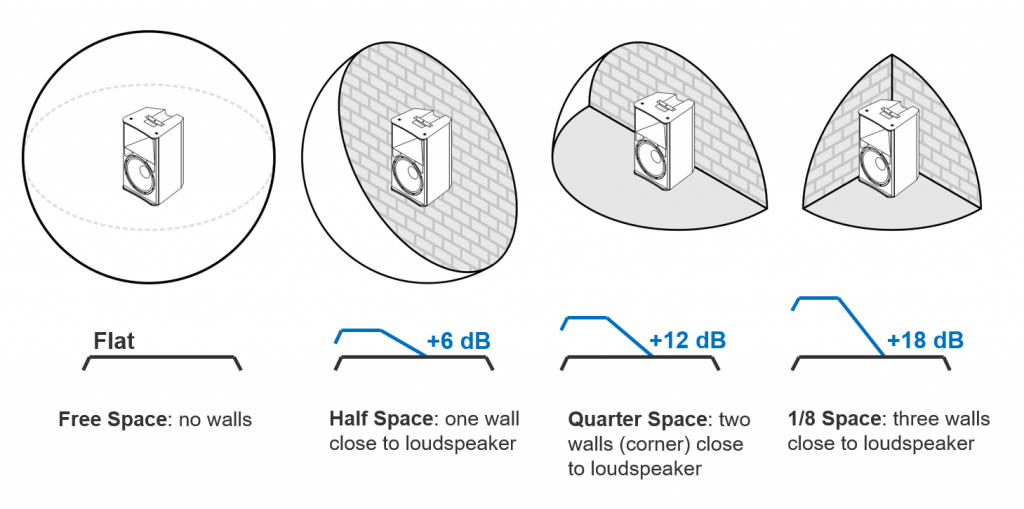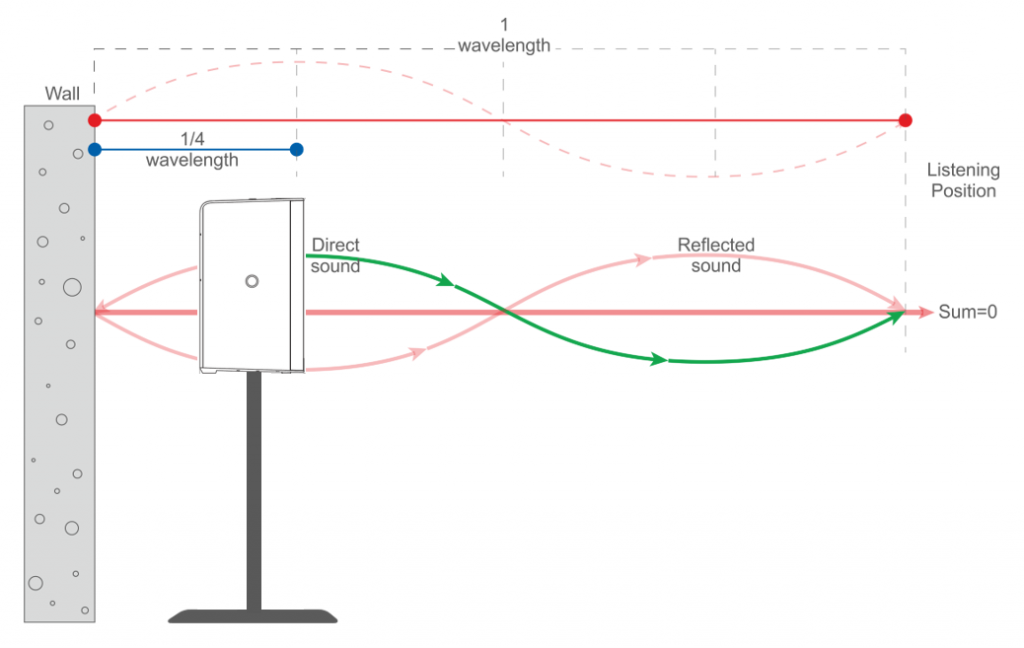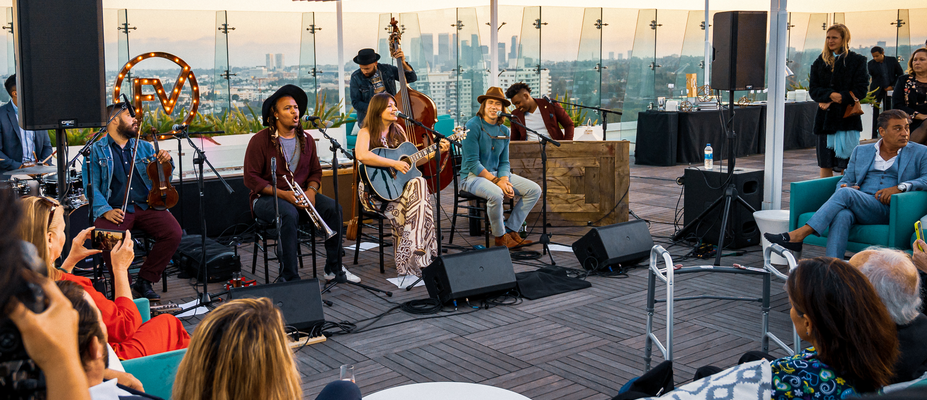QSC loudspeakers are well-known to provide high-performance, accurate reproduction of audio sources in a wide range of applications. However, unlike a controlled studio environment, the real world provides myriad challenges to achieving sonically-pleasing results with QSC or any other loudspeaker. The conditions created by room shapes, ceiling heights, the presence of acoustically reflective or absorptive walls, and many other factors combine to render the process of setting up a sound system challenging. One place to start in addressing environmental challenges is through proper loudspeaker placement. This three-part series aims to provide useful, simple tips to achieve the best possible sound reproduction in typical venues and for the entire audience.
Bass Boost and Radiation Space
Let’s start to look at loudspeaker placement and recall here some fundamentals in the physics of sound. First, sound propagates differently depending on frequencies. As shown below it spans from omnidirectional radiation at low frequencies to highly directive high frequency propagation.

The second term to explain here is the so-called ‘radiation space’ which simply defines the volume into which a loudspeaker is radiating sound. We have to observe that, at low frequency (below 200 Hz), the sound level increases when hard walls limit the radiation space. Every halving of the radiation space by a wall close to the loudspeaker doubles the sound pressure level.
A loudspeaker with a typically flat low frequency response below 200 Hz in free space (ex. your K.2 with ‘Studio Monitor’ Preset selected) produces up to 6 dB higher sound level when placed against a solid wall. In a corner (two walls), this gain increase up to 12 dB!

So, what should you do about this? Well, make sure that for each loudspeaker in your PA system that is placed in one of the situations shown in Figure 2 – beside ‘free space’ – you reduce the bass level output, below 200 Hz or so, a few decibels at a time until the bass reproduction becomes clear, tight and punchy again. To do so, either use the loudspeaker’s on-board EQ – as featured in QSC K.2 Series™ – or setup a shelving-filter below 200 Hz in your mixer – something very easily done in any QSC TouchMix® digital mixer. Remember also that excessive low frequency levels will tend to reinforce certain bass notes, creating resonances and a muddy audio mix with undefined dynamics.
Note that the term ‘against a wall’ (half-space radiation) is applicable for a loudspeaker placed against a wall on a stand or pole-mounted over a subwoofer, as well as for a loudspeaker mounted against a ceiling using mounting brackets. Similarly, a loudspeaker close to a wall corner, or mounted on the wall and against the ceiling, will radiate sound in quarter space. Less likely to happen with a PA system, if a loudspeaker is positioned in a wall corner, and against the ceiling, the radiation space will be the 1/8 space.
Back Wall Cancellation and Loudspeaker Placement
Let’s look at a phenomenon that occurs below 200 Hz. When there is some distance between a loudspeaker and a hard, solid wall behind it, at the frequency where this distance is equal to one quarter of the sound wavelength emitted, the wall reflection is out of phase with the loudspeaker forward radiation. Hence, the sound reflected by the wall at this specific frequency will cancel the loudspeaker’s forward radiation of the same frequency.
For some simple calculations, let’s recall the definition of the speed of sound ‘C’ (at sea level, at 21 degrees Celsius (70 degrees Fahrenheit) under normal atmospheric conditions) which is 344 m/s (1128 ft/s) and that is defined as C = f λ, where ‘f’ represents frequency and ‘λ’ wavelength.
This equation let us easily find the quarter wavelength for any given frequency. As an example, the lowest note on a standard guitar (open low E string) is about 83 Hz. The quarter wavelength is 1.0 m (3.3 ft).
Hence, we can conclude that if a loudspeaker is placed 1 m (3.3 ft) away from a hard, solid wall behind it, its forward-radiating frequency response will display a significant notch in at 83 Hz. This is called ‘low frequency comb filtering cancellation’ and, unfortunately, equalization of the loudspeaker’s output does not help, as the same level change applies also to the reflected sound off the wall. This is why the location of the loudspeaker relative to the back wall has a significant impact on the overall low frequency reproduction quality and musicality.

For live sound applications, the question is therefore: how far from the back wall should your PA system be placed to avoid such cancellations? For this simple calculation, let’s consider a QSC K12.2 active loudspeaker, which features a frequency response extending down to 45 Hz (-10 dB), and let’s calculate the ¼ wavelength at 45 Hz, which is 1.9 m (6.25 ft).
Therefore, if you place a QSC K12.2 loudspeaker further away than 1.9 m (6.25 ft) from the back wall, you will ensure that no cancellation phenomenon will occur and that the full bandwidth of the loudspeaker will be reproduced. You are observing that such a distance depends on the actual loudspeaker’s specifications. A lower cut-off will imply a longer distance to the back wall. In general, such distances can easily be achieved, as typical stage depths are greater than 2 m (6.56 ft), which is also valid for many DJ booth setups.
Now, in certain live setups, delayed or ‘fill’ loudspeakers have to be placed close to the wall behind them. What to do in such cases? To avoid strong cancellation from the back wall, you need to place the loudspeaker’s back as close as possible to the wall. This will ensure that the low frequency output is not compromised. However, make sure, at the same time that the bass boost created by the vicinity of the wall is properly attenuated, as explained in the previous chapter.
Conclusions
Having considered loudspeakers’ radiation spaces and associated bass boosts, as well as back wall cancellation phenomenon, the next article will discuss basic room acoustics variables, explain the ‘critical distance’ and the ‘inverse square law’ in order to be able to achieve consistent loudspeaker coverage in any venue. Stay tuned!
Christophe Anet
Latest posts by Christophe Anet (see all)
- History, Development and Applications of Column Loudspeakers - May 30, 2025
- Why is Dynamic Range so important? - May 30, 2023
- Differences between Flown and Floor-Mounted Subwoofer Deployments - May 2, 2023
